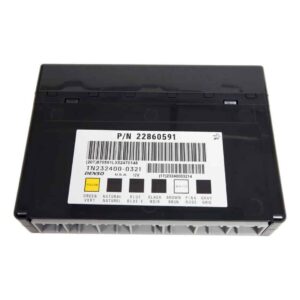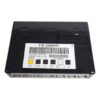Restore Your GM Truck’s Electrical System with a Plug-and-Play Solution
As a technician with over two decades of experience, I’ve seen firsthand how a failing Body Control Module (BCM) can turn a reliable vehicle into a source of constant frustration. If your 2010 Tahoe is plagued by bizarre electrical issues—flickering lights, malfunctioning power windows or locks, a security system that acts up, or a battery that mysteriously drains overnight—the BCM is the likely culprit. It’s the central hub for your vehicle’s body electronics, and when it fails, it creates a cascade of confusing problems.
We take the guesswork and high dealership costs out of the repair. This is a direct-fit replacement Body Control Module, but with one crucial difference: we program it specifically to your vehicle’s VIN before it ships. This means you get a part that’s ready to install right out of the box, loaded with the latest GM software updates. You avoid the hassle of towing your vehicle to a dealer and paying for expensive programming services. Just provide your VIN at checkout, and we’ll handle the rest.
Case Study: A Tricky Diagnosis
A customer brought in a 2010 Yukon XL with a complaint that made no sense at first: the radio would cut out whenever they used the driver-side power window. On top of that, the dome lights would flicker randomly. They had already replaced the battery and the window switch with no luck. A quick scan showed a handful of communication codes (U-codes) pointing to a network issue. Instead of chasing individual components, my experience pointed straight to the BCM. These modules are notorious for causing these exact kinds of seemingly unrelated electrical gremlins. We installed a VIN-programmed BCM, and instantly, every single issue was resolved. It’s a classic example of how one central component can create widespread chaos.
Common Signs of a Failing BCM
A faulty BCM can manifest in many ways. If you’re experiencing any of the following, it’s time to consider a replacement:
- ✔ Erratic or non-functional interior and exterior lights.
- ✔ Power windows, door locks, or mirrors working intermittently or not at all.
- ✔ The security system engaging randomly or preventing the vehicle from starting.
- ✔ A persistent parasitic battery drain that leaves you with a dead battery.
- ✔ Warning lights on the dash, such as the airbag or service security system light.
- ✔ Diagnostic trouble codes (DTCs) related to communication loss, such as U0140, U0155, or U0164.
Your Straightforward Installation Guide
For a 2010 Chevy Tahoe, the BCM is located under the steering column. While professional installation is always an option, a confident DIYer can handle this job. Here’s a basic overview:
- Safety First: Always disconnect the negative terminal from your vehicle’s battery before working on electrical components.
- Access the Module: Remove the lower dash panel beneath the steering wheel to gain access to the BCM. It’s typically held in a bracket with a few screws or clips.
- Disconnect and Remove: Carefully unplug the multiple electrical connectors from the old BCM. Pay attention to the locking tabs on each connector to avoid damage. Once disconnected, remove the old module.
- Install the New BCM: Mount your new, pre-programmed BCM in the same location and securely plug in all the electrical connectors.
- Power Up: Reconnect the negative battery terminal. Start the vehicle and test all functions—lights, locks, windows, radio, etc.—to confirm the repair.
Important Post-Installation Notes
Because this module is central to many systems, a couple of quick relearn procedures may be needed after installation. This is normal and ensures all systems are communicating correctly.
- Airbag System Sync: If your airbag warning light is on after installation, a simple “Setup SDM Primary Key in BCM” procedure is required. This syncs the new BCM with the airbag system and can be done with a professional-grade scan tool.
- Brake Pedal Position Relearn: On some models, a brake pedal position sensor recalibration might be necessary to ensure brake lights and traction control function properly.
Disclaimer: Procedures can vary slightly. Always refer to a factory service manual for your specific vehicle if you are unsure.
Will This Fit My Vehicle?
This BCM is a direct replacement for a wide range of GM vehicles and interchanges with numerous part numbers. Please verify your part number or contact us with your VIN to confirm compatibility.
Replaces Part Numbers: 10382479, 15093910, 15276271, 15299986, 15819552, 15828601, 15837419, 15872388, 15872421, 15880684, 15921352, 15921353, 15948438, 15948439, 20815898, 20839063, 20864767, 20864768, 20921435, 20921436, 20935349, 22860591, 25826124, 25826125, 25847588, 25847589, 25892622, 25910474, 25934762, 25934763, 95151084
Fits Select Models Including:
- Acadia (2007-2012)
- Avalanche 1500 (2010)
- Caprice (2011-2013)
- Captiva Sport (2012)
- CTS (2008-2013)
- DTS (2006-2011)
- Enclave (2008-2012)
- Equinox (2007-2009)
- Escalade, ESV, EXT (2010)
- Express / Savana Vans (2008-2012)
- G8 (2008-2009)
- Hummer H2 (2008-2009)
- Impala (2006-2013)
- Lucerne (2006-2011)
- Monte Carlo (2006-2007)
- Outlook (2007-2010)
- SRX (2007-2009)
- Suburban 1500 (2010)
- Tahoe (2010)
- Torrent (2007-2009)
- Traverse (2009-2012)
- Vue (2008-2010)
- Yukon / Yukon XL 1500 (2010)
Why do you need my VIN?
Your Vehicle Identification Number (VIN) allows us to program the BCM with the exact software and settings for your vehicle’s specific options. This ensures a seamless installation and proper function without needing a trip to the dealership.
Is this a plug-and-play part?
Yes! Because we program it to your VIN before shipping, it is designed to be a plug-and-play installation. In some cases, minor relearn procedures for the airbag or brake pedal sensor may be needed, which is a standard step for this repair.
Where is the BCM located on my 2010 Tahoe?
On the 2010 Chevrolet Tahoe, the Body Control Module is located under the driver’s side dash, near the steering column.
What happens if my airbag light comes on after installation?
This is a common and expected possibility. It simply means the new BCM needs to be electronically ‘introduced’ to the airbag’s computer (SDM). A technician with a professional scan tool can perform the ‘Setup SDM Primary Key in BCM’ procedure in a few minutes to resolve this.
Do I have to return my old BCM?
No. We do not require you to send back your original part. There is absolutely no core charge associated with this purchase.


